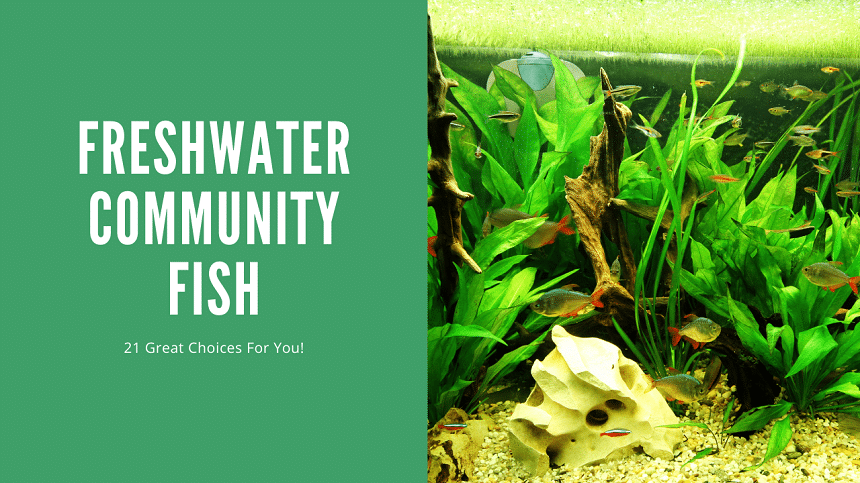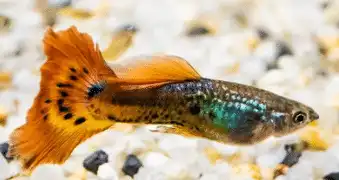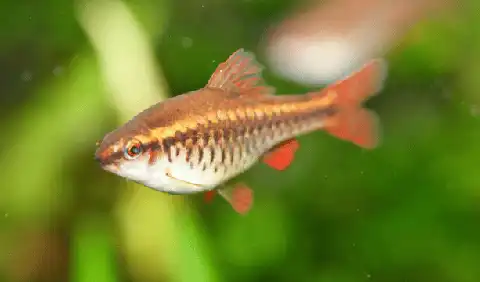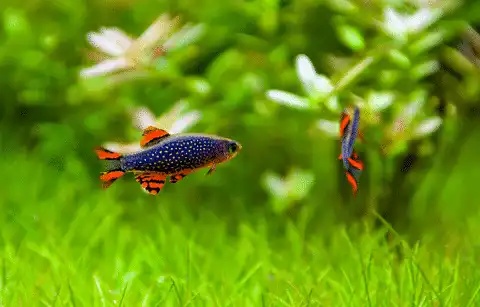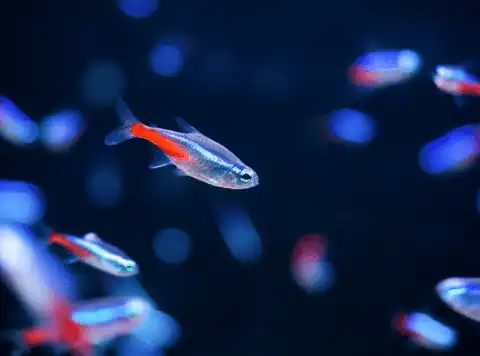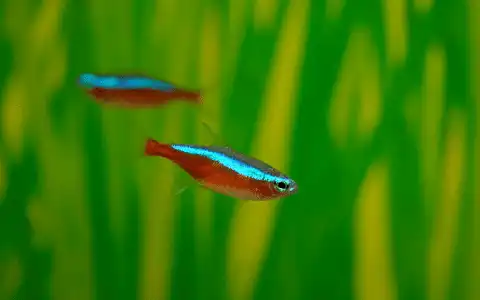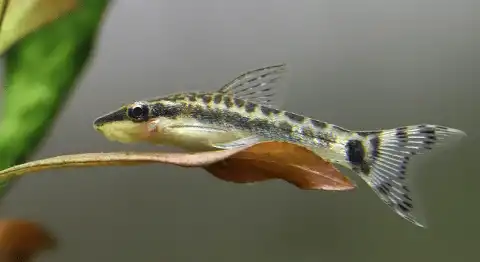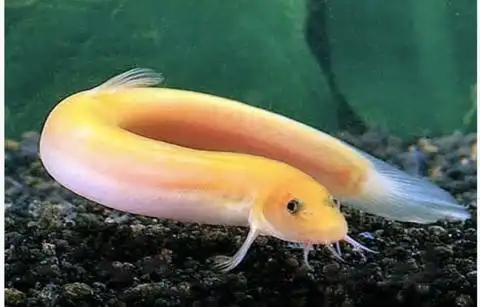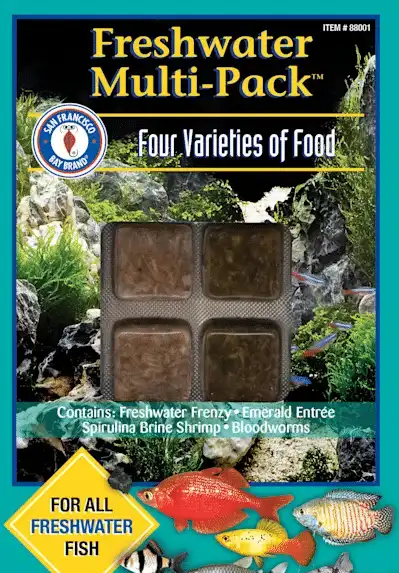Thank you for visiting! By the way… any links on this page that lead to products on Amazon and other stores/partners are affiliate links Aquarium Store Depot earns a commission if you make a purchase.
Many fish keepers love a freshwater community aquarium that is full of different types of fish, but how do you choose compatible fish species? Choosing fish for your freshwater aquarium that won’t fight or hurt each other is very important for a successful community tank! That’s why I’ve put together this list of the best community fish to make your life a little easier.
So let’s dive right in!
What Are Community Fish?
Good community fish are species that can live peacefully with other types of fish. They are not aggressive or dangerous to their fish tank mates in any way. The ideal community tank fish species are:
- Peaceful fish
- Compatible with other species
- Interesting and attractive to observe
- Hardy and adaptable
How To Match
The first rule when matching fish for your community tank is to stock them together with other peaceful aquarium fish. You can check out the fish compatibility chart I have posted for an easy-to-reference guide.
There are also a few less obvious factors to consider, however. Here’s what you need to know:
Water Parameters
All the species in your freshwater tank should be comfortable in the same water parameters. That means they should be comfortable with the same, water temperature, pH, and water hardness. As a rule of thumb, many tropical aquarium fish will prefer softer and slightly acidic water. It’s really easy to buffer your system with natural decorations like driftwood.
Size
In most cases, you should aim to stock your aquarium with similarly sized fish. This is useful for planning how many fish you can keep in your tank and for preventing predation.
Remember, almost all carnivorous or omnivorous species will eat other fish that are small enough to fit in their mouths!
Swimming Level
A healthy mix of bottom dwellers, mid-water, and top-water swimming species will prevent overcrowding in the aquarium. Having fish that swim on all levels of the tank will also create a busier, more lively display tank.
Biotopes
Mixing fish breeds from different parts of the world can be very in interesting, but you can also keep things more natural. Many aquarists enjoy matching species that live together naturally in the same region or natural habitat to create biotope tanks.
For example, a South American river biotope could include species like corydoras catfish, neon tetras, and blue rams. An Asian stream biotope would be another great option and could include fish like the honey gourami and cherry barb.
21 Of The Best Community Fish Species
Now that you know what community species are and how to match them, it’s time to get to know some of the best species of fish for your freshwater aquarium. Pay attention to the following information when considering each species:
- Scientific Name
- Difficulty Level
- Temperament
- Adult Size
- Minimum Tank Size
- Origin
- Diet
- pH
- Temperature
- Planted Tank Suitability
- Difficulty to breed
Here’s a video from our YouTube Channel for those who are visual learners. I’ll go into further detail in our blog post. Please subscribe to our YouTube channel if you find our content helpful.
Let’s get started!
1. Cory Catfish

- Scientific Name: Corydoras spp.
- Difficulty Level: Easy
- Temperament: Peaceful
- Adult Size: 1-4 inches
- Minimum Tank Size: 10-30 gallons (depending on species)
- Origin: South American
- Diet: Omnivorous
- pH: 5.5-7.8 (depending on species)
- Water Temperature: 72-82°F (depending on species)
- Planted Tank Suitability: Yes
- Simming Level: Bottom
There are more than 160 known species of these wonderful aquarium fish. Although Corydoras catfish spend most of their time on the bottom, these funny little fish will shoot up to the surface every now and then to take a breath of air. Corydoras catfish should be kept in groups of 6 or more to see them at their most playful and comfortable.
2. Rasboras
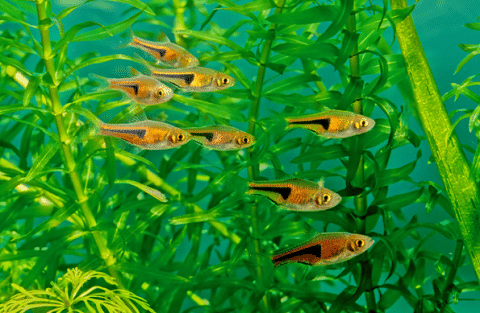
- Scientific Name: Rasbora spp., Boraras spp., etc
- Difficulty Level: Easy
- Temperament: Peaceful
- Adult Size: 0.75-6 inches
- Minimum Tank Size: 5-55 gallons (depending on species)
- Origin: Asia
- Diet: Omnivorous/carnivorous
- pH: 4-8 (depending on species)
- Water Temperature: 68-82°F (depending on species)
- Planted Tank Suitability: Yes
- Swimming Level: Midwater, topwater
There are many different rasbora species in the hobby, ranging from tiny fish like the chili rasbora up to the much larger scissortail species. These Asian schooling fish tend to be very peaceful and make wonderful peaceful community fish. Rasboras are some of the smallest fish in the hobby too, so they are a great choice for nano fish community setups.
3. Guppy
An undemanding fish that is a livebearer. Many varieties available
- Scientific Name: Poecilia reticulata
- Difficulty Level: Easy
- Temperament: Peaceful
- Adult Size: 2 inches
- Minimum Tank Size: 10 gallons
- Origin: South American
- Diet: Omnivorous
- pH: 7-8
- Water Temperature: 72-82°F
- Planted Tank Suitability: Yes
- Swimming Level: All
Guppy fish are the perfect community species for tropical aquariums with a water pH of over 7. These popular fish come in a wide range of different colors and often have big flowing fins.
Guppies are great beginners fish because they are very adaptable and easy to care for. They are livebearers, so if you keep males and females together you can expect to see loads of little fry in your tank!
4. Platies
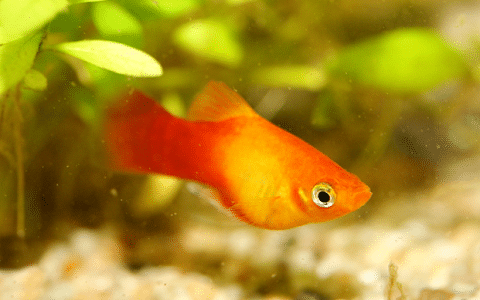
- Scientific Name: Xiphophorus spp.
- Difficulty Level: Easy
- Temperament: Peaceful
- Adult Size: 2-3 inches
- Minimum Tank Size: 15 gallons
- Origin: North & South America
- Diet: Omnivorous
- pH: 6.8-8.5
- Water Temperature: 70-82°F
- Planted Tank Suitability: Yes
- Swimming Level: Midwater, topwater
Like guppies, platy fish are peaceful livebearers that are available in some awesome breeds. They will make an ideal small community fish for your freshwater aquarium and have the added benefit of helping out with algae control.
5. Molly

- Scientific Name: Poecilia sphenops & P. latipinna
- Difficulty Level: Moderate
- Temperament: Peaceful
- Adult Size: 3-5 inches
- Minimum Tank Size: 30 gallons
- Origin: North & South American
- Diet: Omnivore
- pH: 7-7.8
- Water Temperature: 68-82°F
- Planted Tank Suitability: Yes
- Swimming Level: Midwater, top
Molly fish are excellent peaceful aquarium fish for fish keepers with naturally hard water. Like other livebearers, these fish breed freely in the aquarium. These larger livebearers are available in many different colors and fin shapes.
6. Sword Tails

- Scientific Name: Xiphophorus helleri
- Difficulty Level: Easy
- Temperament: Peaceful
- Adult Size:3-6 inches
- Minimum Tank Size: 20 gallons
- Origin: Central America
- Diet: Omnivorous
- pH: 7-8.5
- Water Temperature: 64-82°F
- Planted Tank Suitability: Yes
- Swimming Level: Midwater, top
Swordtails are yet another highly popular livebearer that is available in a huge variety of colors and breeds. What sets swordtails apart is their distinctive long tail fins! They are great community fish for beginners and will do best if kept in a group of one male and a few females.
7. Cherry Barbs
- Scientific Name: Puntius titteya
- Difficulty Level: Easy
- Temperament: Peaceful
- Adult Size: 1.75- 2 inches
- Minimum Tank Size: 15 gallons
- Origin: Asia
- Diet: Omnivorous
- pH: 6-8
- Water Temperature: 68-80°F
- Planted Tank Suitability: Yes
- Swimming Level: All levels
Cherry barbs are beautiful and peaceful aquarium fish from the goldfish family. These active and colorful fish add rich orange-red color to your aquarium. The cherry barb fish is a social species that should be kept in groups of 6 or more fish to see them at their best.
8. Dwarf Gouramis

- Scientific Name: Trichogaster lalius
- Difficulty Level: Moderate
- Temperament: Peaceful
- Adult Size: 3 inches
- Minimum Tank Size: 10 gallons
- Origin: South Asia
- Diet: Omnivorous
- pH: 6-7.5
- Water Temperature:72-82°F
- Planted Tank Suitability: Yes
- Swimming Level: Midwater, top
A pair of dwarf gouramis make a wonderful addition to a peaceful community aquarium. These graceful labyrinth fish are both beautiful and peaceful. Dwarf gouramis are available in many different breeds such as the flame,neon blue dwarf, and honey gouramis for example.
9. Zebra Danio
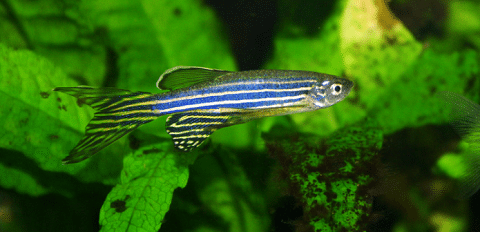
- Scientific Name: Danio rerio
- Difficulty Level: Easy
- Temperament: Peaceful
- Adult Size: 3 inches
- Minimum Tank Size: 10 gallons
- Origin: India
- Diet: Omnivorous
- pH: 6.5-7.5
- Water Temperature: 64-75°F
- Planted Tank Suitability: Possible
- Swimming Level: All levels
Zebra danios are active fish that love darting around the aquarium. These peaceful freshwater community fish can thrive in relatively low water temperatures, making them a great choice for unheated aquariums, and they also get along with lots of fish. These hardy fish are available in long-finned, golden, and Glofish varieties.
10. Celestial Pearl Danio
A great-looking danio fish. Males are more colorful than females. A midway dwelling fish
- Scientific Name: Celestichthys margaritatus
- Difficulty Level: Moderate
- Temperament: Peaceful
- Adult Size: 0.75 inches
- Minimum Tank Size: 10 gallons
- Origin: Myanmar & Thailand
- Diet: omnivorous
- pH: 6.5-7.5
- Water Temperature: 68-79°F
- Planted Tank Suitability: Yes
- Swimming Level: All levels
These colorful little danio fish are also known as the galaxy rasbora. They are an excellent choice for planted nano community tanks.
Celestial pearl danios are very peaceful creatures although males may display and spar with each other. These shy little fish will do best if kept with other peaceful nano fish.
11. Bristle Nose Pleco
The Bristlenose Pleco is a smaller Pleco that does a great job of eating algae. Peaceful and gets along with most fish
- Scientific Name: Ancistrus spp.
- Difficulty Level: Easy
- Temperament: Peaceful
- Adult Size: 5 inches
- Minimum Tank Size: 15 gallons
- Origin: South American
- Diet: Herbivorous
- pH: 5.5-7.5
- Water Temperature: 70-79°F
- Planted Tank Suitability: Yes
- Swimming Level: Bottom
The bristlenose pleco is a very strange and interesting-looking suckerfish. These bottom-dwelling catfish are very peaceful towards their tankmates, but should not be kept in groups with their own species. Bristle nose plecos love grazing on driftwood and they are very helpful in cleaning some kinds of soft algae.
12. Neon Tetras
Use Promo Code ASDFLIPPROMO
One of the most popular freshwater community schooling fish available in the aquarium trade. Great neon blue colors!
- Scientific Name: Paracheirodon innesi
- Difficulty Level: Easy
- Temperament: Peaceful
- Adult Size: 1 inch
- Minimum Tank Size: 15 gallons
- Origin: South American
- Diet: Omnivorous
- pH: 4-7.5
- Water Temperature: 70-77°F
- Planted Tank Suitability: Yes
- Swimming Level: Mid-water
Neon tetras are a stunning fish! These south American beauties are one of the most popular community species in the hobby because of their great color and easy care. Neon tetras are peaceful schooling fish that are perfect for everyone from beginners to experts.
13. Cardinal Tetra
A very popular schooling fish. Looks like the Neon Tetra, but with longer blue and red stripes. Grows larger than a neon tetra as well
- Scientific Name: Paracheirodon axelrodi
- Difficulty Level: Easy
- Temperament: Peaceful
- Adult Size: 1-1.25 inches
- Minimum Tank Size: 15 gallons
- Origin: South American
- Diet: Omnivorous
- pH: 3.5-7.5
- Water Temperature: 73-84°F
- Planted Tank Suitability: Yes
- Swimming Level: Midwater
The cardinal tetra is very similar to the neon tetra but is even more colorful! The main difference between the two species of tetras is the red stripe on the cardinal tetra which extends the whole length of the fish’s body. Cardinals are also slightly larger than neons, but at just over an inch long, they’re still very small fish.
14. Congo Tetra
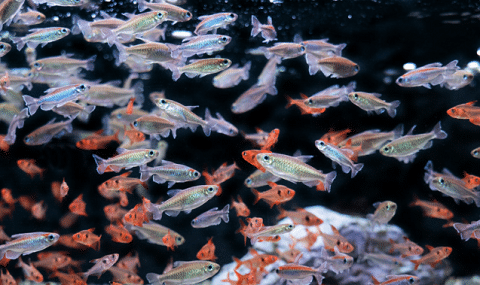
- Scientific Name: Phenacogrammus interruptus
- Difficulty Level: Moderate
- Temperament: Peaceful
- Adult Size: 3 inches
- Minimum Tank Size: 20 gallons
- Origin: Central Africa
- Diet: Carnivorous
- pH: 4-8
- Water Temperature: 75-81°F
- Planted Tank Suitability: Yes
- Swimming Level: Midwater, top
The Congo tetra is one of the most beautiful tetras in the hobby. Congo tetras are native to Africa, unlike most other species which occur in South America. They are very peaceful but can be pretty shy if kept with larger or very active fish.
15. Black Skirt Tetra
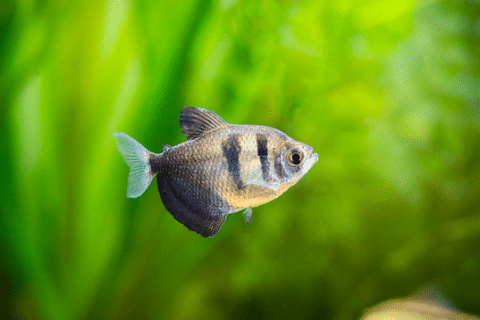
- Scientific Name: Gymnocorymbus ternetzi
- Difficulty Level: Easy
- Temperament: Peaceful
- Adult Size: 2.4 inches
- Minimum Tank Size: 15 gallons
- Origin: South American
- Diet: Omnivorous
- pH: 6-7.5
- Water Temperature: 70-82°F
- Planted Tank Suitability: Possible
- Swimming Level: Midwater, top
The black skirt or black widow tetra is a really cool schooling tetra for community tanks. They might not be the most colorful tetras but their bold black markings and curios fin and body shape make up for that. These interesting-looking fish are very peaceful if kept in schools of at least 6 fish or so.
16. Otocinclus
A small algae-eating fish. Also great with freshwater shrimp.
- Scientific Name: Otocinclus spp.
- Difficulty Level: Easy
- Temperament: Peaceful
- Adult Size: 2 inches
- Minimum Tank Size: 10 gallons
- Origin: South America
- Diet: Algae
- pH: 6-7.5
- Water Temperature: 74-79°F
- Planted Tank Suitability: Yes
- Swimming Level: All levels
These tiny sucker fish feed on algae, which helps to keep the glass, plants, and other surfaces in your tank clean. It’s fascinating to watch them feed as they stick to the glass, but they will also swim around in the midwater of the tank if kept in a school of at least 6 fish or so. Otos are great fish for the planted aquarium but should not be added to tanks that do not produce any algae.
17. Ram Cichlids
- Scientific Name: Mikrogeophagus ramirezi & M. altispinosa
- Difficulty Level: Moderate
- Temperament: Peaceful
- Adult Size: 1.5 inches
- Minimum Tank Size: 15 gallons
- Origin: South America
- Diet: Omnivorous
- pH: 4-7
- Water Temperature: 81-86°F
- Planted Tank Suitability: Yes
- Swimming Level: Midwater, bottom
If you thought all cichlids were big and mean, think again! Rams are small, shy fish that can be kept in community tanks with the right tankmates. It is best to keep just a pair of these stunning cichlids unless you have a tank of 40 gallons or more. Ram cichlids (video source) are tropical fish that need high water temperatures, so make sure their tank mates are compatible.
18. Glass Catfish

- Scientific Name: Kryptopterus vitreolus
- Difficulty Level: Moderate
- Temperament: Peaceful
- Adult Size: 2.5 inches
- Minimum Tank Size: 30 gallons
- Origin: Southeast Asia
- Diet: Carnivorous
- pH: 4-7
- Water Temperature: 68-79°F
- Planted Tank Suitability: Yes
- Swimming Level: Midwater, top
The glass catfish is perfect for aquarists who want something a little more unusual in their tank. These Asian catfish are translucent, and you can see practically every bone in their bodies! They are very calm fish that prefer to school together, so make sure you keep at least 5 of them in the same tank.
19. Dojo Loach
A bottom-dwelling fish that is very adaptable. Compatible in both tropical and coldwater environments
- Scientific Name: Misgurnus anguillicaudatus
- Difficulty Level: Moderate
- Temperament: Peaceful
- Adult Size: 6-10 inches
- Minimum Tank Size: 50 gallons
- Origin: Asia
- Diet: Carnivorous
- pH: 6.5-8
- Water Temperature: 50-82°F
- Planted Tank Suitability: Yes
- Swimming Level: Bottom
Dojo loaches are an awesome addition to a larger peaceful community tank. They are also known as weather loaches because they seem to know when the weather will change! These eel-like bottom feeders are very hardy and make a great choice for unheated aquariums. If this loach is too large for your aquarium, you can look at these other loaches in this post.
20. White Cloud Mountain Minnows
A very peaceful fish that does well in coldwater fish. Other minnow varieties are also available
- Scientific Name: Tanichthys albonubes
- Difficulty Level: Easy
- Temperament: Peaceful
- Adult Size: 1.5 inches
- Minimum Tank Size: 10 gallons
- Origin: China
- Diet: Carnivorous
- pH: 6-8.5
- Water Temperature: 57-72°F
- Planted Tank Suitability: Yes
- Swimming Level: Midwater, top
White cloud mountain minnows are another beautiful fish that can be kept in unheated aquariums. These colorful schoolers prefer cooler water than most tropical fish. They are available in beautiful golden and long-finned forms, although the wild type looks just as good if you ask me!
21. Glofish Tetras & Danios
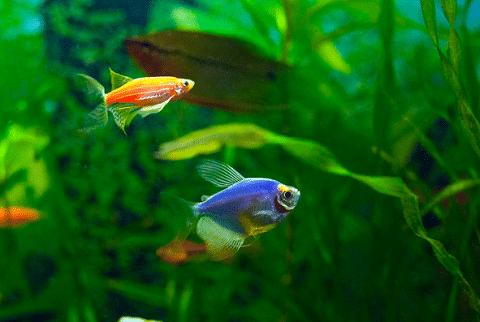
- Scientific Name: Gymnocorymbus ternetzi & Danio rerio
- Difficulty Level: Easy
- Temperament: Peaceful
- Adult Size: 2.4-3 inches
- Minimum Tank Size: 15 gallons
- Origin: Captive
- Diet: Omnivorous
- pH: 6.5-7.5
- Water Temperature: 70-75°F
- Planted Tank Suitability: Possible
- Swimming Level: Midwater, top
The Glofish are a collection of several genetically modified fish species that just burst with color! For a really amazing display, try keeping these fish in a tank with blue LED lighting.
Not all of the Glofish species are peaceful aquarium fish, but the glofish tetras and zebra danios are perfect! The glofish barbs, betta fish, and sharks are more aggressive fish that should not be added to a community.
Freshwater Tank Setup
When choosing a freshwater tank for a community, bigger is generally better. Most of the species in this list will be happiest if kept in a group of 6 or more individuals, so the numbers add up quickly as you introduce new species to the tank.
Luckily, that doesn’t mean you need a huge aquarium to put together an awesome community! A 30-gallon tank or larger would be an awesome place to start, but you can have great success with a tank of half this size too.
Once you’ve chosen your tank size, it’s time to get it set up for your fish. Read on to learn how.
Substrate & Decorations
Adding substrate and decorations to your aquarium can do more than just make it look pretty.
The substrate also provides a place for your fish to forage and for plants to root themselves. Decorations and hardscape features like lava rock and driftwood also create structure and hiding places where your fish can explore and relax.
Editor's Choice
Manzanita offers it all. Great shape, low tannins, quick to water log and reasonably priced. It's the ultimate driftwood!
You can get creative with your choice of substrate color, although fish tend to be most comfortable over darker natural colors. Make sure your substrate, hardscape, and ornaments are aquarium-safe and thoroughly washed before adding them to the tank.
Filtration
Apart from the tank itself, there are a few important pieces of hardware that you will need to put together a great fish community. The most important of these is the filter. We run into several filter types in freshwater aquariums. From easiest to most high end they are:
- Sponge filters
- Internal filters
- Hang-on back filters
- Canister Filters
- Aquarium Sumps (rare in freshwater)
Your choice will depend on factors like your budget and stocking rate, but be sure to select a model that is designed for your aquarium size or larger. Canister filters are often considered the pinnacle in filtration systems with freshwater tanks. A model like the OASE Biomaster will get you professional level filtration that will last for years.
For The Professional Aquascaper
With an easy to remove prefilter chamber and intregrated heater chamber, this is the most advanced canister filter you can buy today. German engineered and aquascaper approved!
Lighting
Lighting is one of the pieces of gear we run into if we are looking into planted tanks. You want a light that is full spectrum and will support plant growth. An easy to use moderately powered light like the Current USA Serene RGB is great for someone who want to venture into keeping many plants. Plants are great for your community fish as it makes them feel safer.
Current USA's offering into aquascaping is an incredible value. Spectrum, spread, easy to program and great PAR output.
Providing a natural period of daylight is important for your fish’s health. Run your freshwater aquarium lighting on a timer so that it switches on and off automatically at the same time each day. 8 hours of lighting per day is recommended.
Heating
Most of the popular freshwater aquarium fish are tropical species that require consistently warm water temperatures. For most of us, that means an aquarium heater is an essential piece of equipment. Choose a model designed for your tank size that has an adjustable temperature range.
Best Aquarium Heater
The ultimate in heater reliability today. It is the holy grail of high end aquarium heaters. A must for anyone with prized livestock.
If you do not want to run a heater, you can opt to house coldwater fish. There are many peaceful community fish that will tolerate room temperature or lower water
Live Plants
A planted aquarium has many amazing benefits for your fish. Aquarium plants help to clean and oxygenate the water, and floating plants can help your fish feel safer and more confident.
You don’t need to rush into growing a high-tech, heavily planted tank, however. Low light and beginner plants are great to try. Here would be a few examples:
How to Care For Your Pets
Now that you know how to set up a great environment for your freshwater aquarium community, it’s time to learn about care and maintenance!
Maintaining beautiful fish tanks and healthy fish is all about consistency. Once you settle into the right routine and habits, your tank will really thrive.
Community Tank Maintenance
Cleaning and maintaining your freshwater community aquarium regularly will keep your fish healthy and your tank looking great. You’ll need an aquarium test kit to monitor your water quality. This will help you determine your water parameters and whether you’re performing enough maintenance on your tank.
Set aside a little time every week or two to perform a partial water change. This will reduce the concentrations of nitrate (a by-product of fish waste, decaying plant matter, and uneaten fish food) to keep the water safe and healthy.
This is the perfect time to suck up any dirt that has collected on the substrate and to clean algae off the glass. Inspect your filter media and rinse it out with the water you have removed from the tank. The new water you put in should be treated with a water conditioner and brought up to the same temperature as the rest of your tank before being added.
Feeding
Feeding aquarium fish a healthy, balanced diet is essential for their long-term care. Different fish have different diets, but most freshwater community species will thrive on a high-quality pellet or flake food as their regular food source. Frozen food is great to try if you can get your fish to eat it. Bottom dwellers can miss out on fish flakes and floating foods, so provide them with sinking tablets or pellets.
This frozen food pack contains 4 types of formulas in one package. A great overall package for freshwater fish
Supplementing their diet with unprocessed food sources will help to bring out the best in their colors and behaviors. The following supplementary treats are recommended:
- Brine shrimp
- Insect larvae like bloodworms
- Vegetables
Algae eaters like otocinclus catfish need a healthy source of algae to feed on. They should not be introduced to new, algae-free tanks for this reason. If your algae eaters have depleted the algae in your tank, their diet should be supplemented with blanched vegetables, algae wafers, and gel foods.
Overfeeding fish is one of the biggest causes of poor water quality and ammonia spikes in home aquariums. To prevent this, feed your fish once or twice a day and provide only as much food as they can finish in a minute or two. It’s also a good idea to observe your fish and make sure that all of them can access enough food.
Breeding
Different species of fish have different breeding strategies. As a general rule, however, the community aquarium is not a good place for breeding fish.
This is because most fish love eating the eggs and fry of their tank mates! If you plan on breeding your fish, your best bet is to set up a small, dedicated breeding tank and carefully research the best method for your specific species.
Where To Buy
All of the species in this list are common and easy to find. Your local fish store is usually a great place to shop for community species, and they will usually have most (or even all) of these fish in stock.
If you’re looking for a safe and convenient alternative, consider buying from a reputable online dealer!
FAQs
What varieties can live together?
With enough space and compatible water parameters, just about any similarly sized and peaceful fish can live together. Remember to keep each species in a big enough group to keep them peaceful and confident.
What big fish can live in a community tank?
Although the species in this list are all relatively small fish, there’s nothing to stop you from putting together a large fish community tank. The same rules apply, only you’ll need a much bigger tank! The rubber lip pleco, angelfish, and clown loaches are all great examples of larger freshwater fish for a community tank.
What is the most peaceful fish?
Otocinclus catfish are probably the most peaceful community fish in the hobby. These tiny algae eaters are great for the established planted community tank and they’re even safe to keep with shrimp and most snails.
What tropical fish are like these?
There is a large number of tropical community fish in the hobby. Most of the tetras, rasboras, and livebearers are great examples. It is very important to research the needs and behavior of any fish breed before adding it to a community tank.
What fish are generally known as this type?
Fish species that are calm and peaceful with other fish are generally referred to as community species. These fish can live together in harmony without causing their other tank mates any harm. Most tend to be small and won’t display aggression to other fish or attempt to eat them.
Final Thoughts
Setting up your first freshwater community tank is an awesome experience that we aquarists never forget. Choosing the right fish for your freshwater aquarium can be a little daunting at first, but if you choose from this list, you’ll have nothing to worry about. Just remember to take your time, do your research, and have fun!
Do you have your own aquarium with community fish? Let us know about your favorite community species in the comments below!
- About the Author
- Latest Posts
I’m thrilled that you found Aquarium Store Depot! Here you’ll find information on fish, aquariums, and all things aquatics related. I’m a hobbyist (being doing this since I was 11) and here to help other hobbyists thrive with their aquariums! I adhere to a high quality Editorial Process and Review products with real life field usage and practical analysis.

